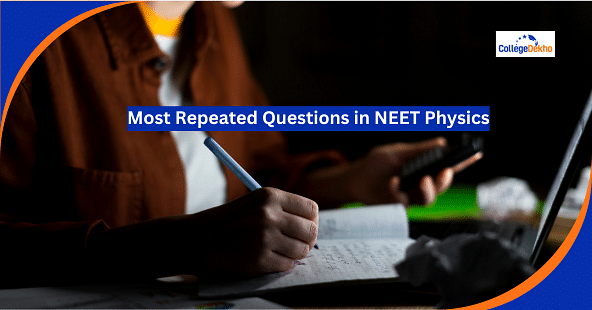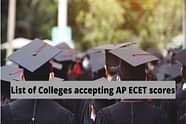
Most Repeated Questions in NEET Physics are usually asked from topics such as Electrostatics, Current Electricity, Electromagnetic Waves, Optics, Physics and Measurement, Kinematics, Laws of Motion, Work Energy & Power, Gravitation, and Properties of Solids and Liquids, among others. The list of most repeated questions in NEET Physics is prepared by analyzing the year-wise NEET question papers and identifying the similar topics asked in all of them combined. While the National Testing Agency (NTA) does not frame the same questions year after year on repeat in the entrance exam, questions on similar topics or twisted in a different format are often identified by students appearing for NEET entrance exams.
Therefore, referring to the list of most repeated questions in NEET Physics will allow aspiring NEET students to underline the topics of utmost importance, to be covered in the upcoming exam. Moreover, the most repeated questions in NEET Physics usually hold maximum weightage in the entrance exam, aiding students to secure a good score in the NEET Physics section. For example, in the NEET 2024 Exam, about 47 questions were recorded to be repeated from NEET previous year’s question papers . To learn about the list of most repeated questions in NEET Physics, refer to the detailed information provided below.
List of Most Repeated Questions in NEET Physics
Some of the important questions from the list of most repeated questions in NEET Physics have been provided below for all NEET aspirants to derive references from:
Q1. An electric dipole is placed at an angle of 30 degrees with an electric field of intensity 2×10-5NC−1. It experiences a torque equal to 4 Nm. Calculate the magnitude of charge on the dipole if the dipole length is 2 cm.
A1) q=4×10
Q2. Two hollow conducting spheres of radii R1 and R2 (R1 >>R2) have equal charges. What would the potential be?
A2) The potential on the smaller sphere is higher, and on the larger sphere is lower.
Q3. A spherical conductor of radius 10 cm has a charge of 3.2 ×10−7C distributed uniformly. What is the magnitude of the electric field at a point 15 cm from the center of the sphere?
A3) E=1.28×10^3 N/C
Q4. A hollow metal sphere of radius R is uniformly charged. The electric field due to the sphere at a distance r from the center
A4) E=4πϵ01Q/r^2 for r>R
Q5. Two point charges, -q and +q are placed at a distance of L, as shown in the figure. The magnitude of electric field intensity at a distance R (R>>L) varies as
A5) E∝1/R^3
Q6. A capacitor is charged by a battery. The battery is removed, and another identical uncharged capacitor is connected in parallel. The total electrostatic energy of the resulting system:
A6) The total electrostatic energy doubles.
Q7. A capacitor is 2μF charged as shown in the diagram. When the switch S is turned to position 2, the percentage of its stored energy is dissipated?
A7) 50%
Q8. The solids that have the negative temperature coefficient of resistance are
A8) Carbon, Silicon
Q9. 10 resistors, each of resistance R, are connected in series to a battery of emf E and negligible internal resistance. Then, those are connected in parallel to the same battery, the current is increased n times. The value of n is:
A9) n=10
Q10. The resistance of a wire is 'R' ohm. If it is melted and stretched to 'n' times its original length, its new resistance will be
A10) Rnew =n^2R
Q11. As the temperature increases, the electrical resistance.
A11) Increases
Q12. A 250 – Turn rectangular coil of length 2.1 cm and width 1.25 cm carries a current of 85μA and is subjected to a magnetic field of strength 0.85 T. Work done for rotating the coil by 180o against the torque is
A12) Work done = 250 x 85 x 10^6 x 0.85 x 2.1 x 1.25 x π
Q13. A long wire carrying a steady current is bent into a circular loop of one turn. The magnetic field at the center of the loop is B. It is then bent into a circular coil of n turns. The magnetic field at the center of this coil of n turns will be
A13) B new =nB
Q14. A bar magnet is hung by a thin cotton thread in a uniform horizontal magnetic field and is in an equilibrium state. The energy required to rotate it by 60o is W. Now the torque required to keep the magnet in this new position is
A14) τ= mBsin(60∘)
Q15. A long solenoid of radius 1 mm has 100 turns per mm. If 1 A current flows in the solenoid, the magnetic field strength at the center of the solenoid is
A15) B=1.26×10^−1 T
Q16. The magnetic potential energy stored in a certain inductor is 25 mJ when the current in the inductor is 60 mA. This inductor is of inductance
A16) L=13.89H
Q17. An inductor 20 mH, a capacitor 100 μF, and a resistor 50 reconnected in series across a source of emf, V=10 sin 314 t. The power loss in the circuit is
A17) Power loss = I^2R
Q18. For Young's double-slit experiment, two statements are given below :
Statement I: If the screen is moved away from the plane of slits, angular separation of the fringes remains constant.
Statement II: If the monochromatic source is replaced by another monochromatic source of larger wavelength, the angular separation of fringes decreases.
In the light of the above statements, choose the correct answer from the options given below.
A18) Both statements are true.
Q19. In total internal reflection when the angle of incidence is equal to the critical angle for the pair of media in contact, what will be the angle of refraction?
A19) 90°
Q20. The area of the rectangular field (in m2) of length 55.3 m and breadth 25 m after rounding off the value for correct significant digits are.
A20) 1320m^2
Also Read:
Most Repeated Questions in NEET
How to Study NEET Physics Most Repeated Questions
To study the NEET Physics most repeated questions for the upcoming entrance exam, students must refer to the following crucial points mentioned below:
- Refer to the previous years’ NEET question papers for Physics.
- Refer to the NCERT textbooks for reliable solutions to the NEET Physics questions.
- Build a strong fundamental learning base to understand the difficult questions properly.
- Create flashcards to learn formulas
- Create individual chapter-wise notes based on the most repeated questions in NEET Physics.
- Enhance the preparation process by taking regular mock tests to get accustomed to the list of the most repeated questions in NEET Physics.
Also Read:
Common questions in the list of most repeated questions in NEET Physics are usually asked from Electromagnetic Waves, Optics, Physics and Measurement, Kinematics, Laws of Motion, Work Energy & Power, Gravitation, etc.
For more articles related to Nursing, Paramedical, Medical, and Pharmacy, stay tuned to CollegeDekho.
Are you feeling lost and unsure about what career path to take after completing 12th standard?
Say goodbye to confusion and hello to a bright future!

NEET Previous Year Question Paper
Was this article helpful?




















Similar Articles
West Bengal NEET UG Merit List 2025 (Soon): Download MBBS/BDS Rank List PDF
List of Important Topics to Study for NEET PG 2025
Chhattisgarh NEET Merit List 2025: PDF Download, Direct Link, Document Verification
Meghalaya NEET Merit List 2025: Dates, How to Download MBBS/BDS Rank List PDF, Topper’s List
Goa NEET UG Merit List 2025 (Soon): Dates, How to Download, MBBS/BDS Rank List PDF
Maulana Azad Medical College NEET PG Cutoff 2025 (Expected): Check round-wise and category-wise cutoffs